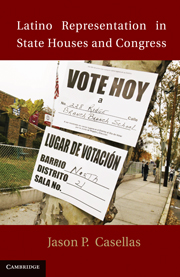Book contents
- Frontmatter
- Contents
- List of Tables
- List of Figures
- Acknowledgments
- Introduction
- 1 Latinos in Legislatures
- 2 The Effects of Population, Turnover, and Term Limits on Latino Representation
- 3 District Composition and the Election of Latino Candidates
- 4 Electing Latinos in Non-Latino Majority Districts
- 5 Voices from Within
- 6 Roll Call Voting Behavior of Latino Legislators
- 7 Conclusion
- Appendix A
- Appendix B
- Appendix C
- Appendix D
- Appendix E
- References
- Index
3 - District Composition and the Election of Latino Candidates
Published online by Cambridge University Press: 10 January 2011
- Frontmatter
- Contents
- List of Tables
- List of Figures
- Acknowledgments
- Introduction
- 1 Latinos in Legislatures
- 2 The Effects of Population, Turnover, and Term Limits on Latino Representation
- 3 District Composition and the Election of Latino Candidates
- 4 Electing Latinos in Non-Latino Majority Districts
- 5 Voices from Within
- 6 Roll Call Voting Behavior of Latino Legislators
- 7 Conclusion
- Appendix A
- Appendix B
- Appendix C
- Appendix D
- Appendix E
- References
- Index
Summary
“There is no elevator to the top. You have to take the stairs, and take it one step at time.” – Dr. Juan Andrade on Latino electoral prospects
After having addressed the institutional and demographic determinants of Latino representation across all fifty states, this chapter delves into district-level determinants of Latino representation in states with significant Latino populations to estimate the probability of electing Latino candidates. In particular, this chapter addresses the following questions: How does the ethnic composition of a legislative district affect the probability that the district will elect a Latino candidate? Are Latino candidates advantaged when they run in districts with citizens who share their ethnic heritage? At what point does the ethnic composition of a district create an advantage for Latino candidates? Do districts need to be majority-Latino before they tend to elect Latino candidates, or is there a lesser threshold where Latino candidates become competitive? If so, what is that threshold? What about other minority groups? Does it matter how many African-American citizens reside in a district? Are Latino candidates advantaged when a district's African-American and Latino citizens outnumber a district's Anglo citizens?
Why might the ethnic composition of a district affect the chances of electing a Latino legislator? First, a district's composition affects the supply of candidates for potential office. In many instances, Latinos who have been successful in winning state legislative seats began their careers on school boards or city councils in heavily Latino districts. They first become well known in the local community.
- Type
- Chapter
- Information
- Latino Representation in State Houses and Congress , pp. 51 - 75Publisher: Cambridge University PressPrint publication year: 2010



